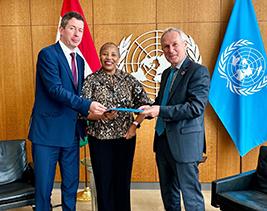Things You Need To Know
5 things you should know about the SDG Stimulus to deliver the 2030 Agenda

Without sufficient financing, the Sustainable Development Goals (SDGs) will remain distant. Raising these resources has become even more urgent following successive global crises. Amid difficult economic and financial conditions, and without mitigating actions, further backsliding of the SDGs is highly likely. Commitment to the SDG Stimulus can jumpstart investment at scale to achieve the 2030 Agenda. Here are 5 things you need to know:
- 1. The SDGs are backsliding
The global economy is facing multiple shocks that are reversing progress on the SDGs. A “great finance divide” has sharply curtailed the ability of many developing countries to respond to shocks and to invest in sustainable development and climate action.
- 2. SDG Stimulus calls for $500 billion in additional SDG investments annually
The UN's SDG Stimulus Plan aims to offset the challenging market conditions that many developing countries face. It calls for scaling up financing and investment in the SDGs by at least $500 billion per year. It includes three areas for immediate action: tackle the high cost of debt and rising risks of debt distress; massively scale up affordable long-term financing; and expanding contingency financing to countries in need.
- 3. Tackling debt and the risk of debt distress
To tackle the high cost of debt and rising risks of debt distress, the SDG Stimulus calls on the G20 to develop an improved multilateral debt relief initiative that supports debt payment suspensions, debt exchanges, and/or debt reductions, with a clear mechanism to include private creditors. It asks donors to scale up debt for climate and SDG swaps, and for all creditors to include majority voting provisions in contracts and make greater use of risk-sharing debt instruments. The international community must also work towards structural solutions.
- 4. Scaling up affordable long-term financing
The SDG Stimulus calls for a massive boost in investment in developing countries. Public development banks, including multilateral development banks (MDBs), are uniquely positioned to accelerate this investment. MDBs can raise lending to $500 billion per year through a variety of measures. MDBs and their shareholders should sizably increase MDB capital bases; more efficiently use their balance sheets; and re-channel SDRs through MDBs. MDBs should also improve lending terms, including through longer terms, lower interest rates, use of state-contingent clauses, and increased lending in local currencies.
- 5. Expanding contingency financing
To address countries’ liquidity needs, the SDG Stimulus calls on the international community to significantly expand contingency financing. Countries with unused Special Drawing Rights (SDRs) should re-channel unused SDRs, including through MDBs or a new trust to finance climate mitigation projects in developing countries. As shocks become more frequent and interconnected, IFI shareholders should explore new quick-disbursing financing instruments, increase access limits to emergency lending windows, and more automatic issuance of SDRs.
For more information: SDG Stimulus
 Welcome to the United Nations
Welcome to the United Nations